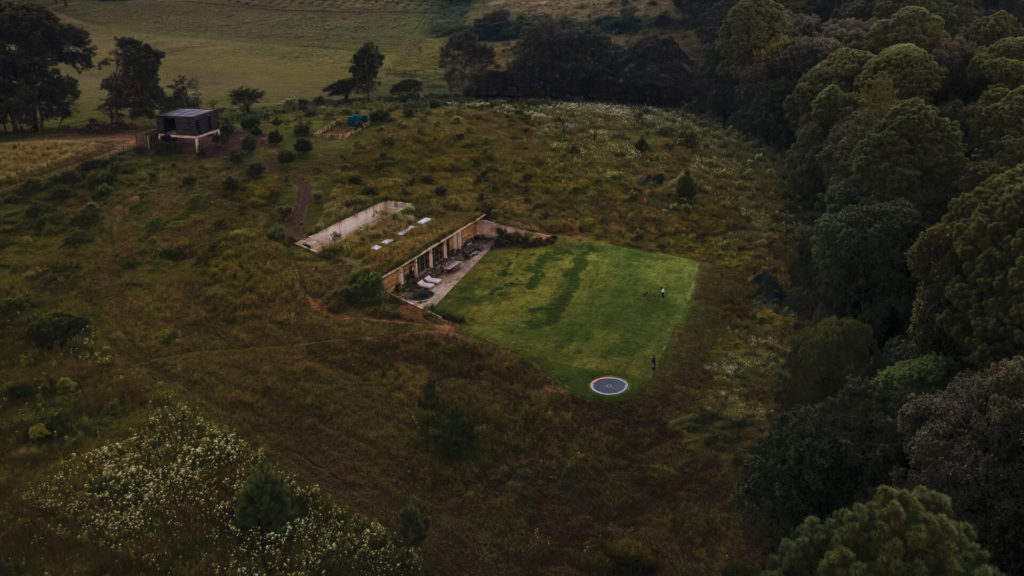[ad_1]
Peculiar and disappearing into the Mexican landscape, Casa Aguacates (the Avocado House) represents the “fifth facade” in its underground architecture opening itself to the skies in perpetuity. Co-existing in “pleasant tension” with the blooming avocado fields that slope into a dense forest and glen, the residence designed by Francisco Pardo doubles up as a weekend retreat, situated some hours outside of Mexico City, in the rural lake town of Valle de Bravo in Mexico.
Resting tranquil in a valley between mountains, offering scenic views of nature and enjoying perennially agreeable weather, the built form remains delicate and unhurried in the belly of the earth, in constant spiritual dialogue with nature.
“The main idea was to have a view of the forest, but the client also wanted to leave the avocado field intact, which is how we arrived at the decision of burying the house,” explains Pardo. Providing the project with its moniker, an abundance of vegetal smelling, lush avocado trees sprout above the almost hidden, unassuming residential architecture, overlooking treetops of the verdant forest owing to its natural slope.

Pardo reveals that since the young clients practice hang gliding, the pair took a special interest in what they considered “the fifth facade” — the view from the sky. “The intention to have a minimal impact from that perspective became the project’s defining characteristic,” continues Pardo.
The program for the 442 sqm residential design is kept intentionally simple, comprising an open plan layout for the kitchen, dining room and living room that stays on display on the ground floor, spilling into a circular pool on one end, and the lush grassy patio on the other side. A massive black fireplace, also designed by Francisco Pardo, graces the living room expanse of the holiday home poised meekly between the earth and the sky.
This is followed by a more private, monastic aesthetic that decorates the master bedroom, two additional guest rooms and a studio surrounding the former spaces. Four linear skylights perforate the roof of the trapezoidal structure which is taken over by greens, once again, blending itself with the stretching landscape. The soil covering the roof also benefits the residence by helping reduce and maintain temperature considerably, doing away with extensive consumption of artificial energy and insulation throughout. The Avocado House thus revels in being a contemporary piece of architecture that celebrates quiet domesticity existing in the abundant, and near overwhelming wilderness.
While the front portion remains sunken below ground, the rear area was pierced to become an interior patio, becoming another channel for maximising daylight and ventilation, as a juxtaposition of natural elements with the concrete architecture. As the Mexican architects explain, “on one side, a view of untamed greenery; on the opposite, a domesticated landscape. Thus, the project exists between two realities, functioning as a subtle expression of architecture’s ability to exercise control over — and coexist in pleasant tension with — its natural surroundings.”
Leaning towards minimalism, the material palette employed for Casa Aguacates remains ascetic and radical, as is the case with most other projects by Francisco Pardo Arquitecto. “Especially because it is a weekend home, we wanted to ensure it would be very low maintenance,” relays Pardo. A bare concrete structure is interrupted only by walls coated in Chukum, a natural stucco from the region of Yucatán, Mexico, and partitions made of pinewood, reused after they had functioned as falsework during construction.
“We actually also used more of that leftover wood to construct a cabin above the house, which can be a service area or a lookout point, because it offers panoramic views of the site,” the design team says. The fluid and restrained interior design mainly comprises a materiality of treated wood, bare concrete and glass, chosen for easy maintenance, and minimising the impact on the site.
The quiet power of the project emanates from its use of reclaimed and locally sourced materials, the meticulous inclusion of soft textures and muted hues, in a union that deeply respects nature. Establishing intimacy with the rhythms of nature, Casa Aguacates maintains a humanised, sober and sturdy existence, far from the frenzied pace of urban life.
The limited number of walls and furniture as well as the bare décor and accents injecting the insides of the home are successful in carrying inside the cosy elements of the outdoors, manifesting the client’s wishes for a retreat immersed in nature and slow-living.
Project Details
Name: Casa Aguacates
Location: Valle de Bravo, Mexico
Area: 442 sqm
Year of completion:
Architect: Francisco Pardo
Engineering: Luis David Moctezuma, Alejandro Moctezuma
Collaborators: La Metropolitana, Luz Design
[ad_2]
Source link






















